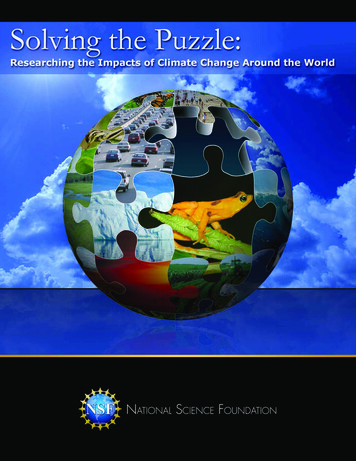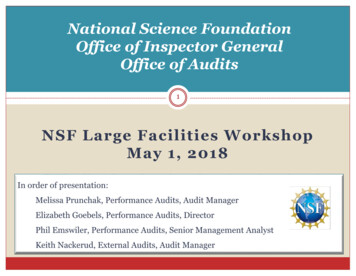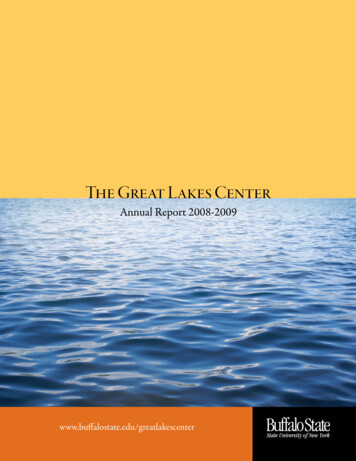
Transcription
On the cover: The climate change “puzzle” includes pieces from science and engineering fields including ecology, glaciology, atmosphericscience, behavioral science, and economics. The photos in this puzzle collage represent the various fields that contribute to our full understandingof Earth’s climate. The missing puzzle piece symbolizes the need for continued basic research on global climate change and variability.Cover design: Adrian Apodaca, National Science FoundationCover photo credits: 2009 JupiterImages Corporation (background)Sphere: top row, left to right: David Cappaert, Bugwood.org, University Corporation for Atmospheric Research; 2009 JupiterImagesCorporation. Second row: Eva Horne, Konza Prairie Biological Station; 2009 JupiterImages Corporation (2). Third row: 2009JupiterImages Corporation; Jeffrey Kietzmann, National Science Foundation; Forrest Brem, courtesy of NatureServe; Digital Vision, GettyImages. Fourth row: Jim Laundre, Arctic LTER; 2009 JupiterImages Corporation; Lynn Betts, USDA Natural Resources Conservation Service;Peter West, National Science Foundation. Bottom row: David Gochis University Corporation for Atmospheric Research; UniversityCorporation for Atmospheric Research
SOLVING THE PUZZLE:Researching the Impacts of Climate Change Around the World
TABLE OF CONTENTSIntroduction1Sky8Sky Research HighlightsSeaSea Research HighlightsIceIce Research HighlightsLandLand Research HighlightsLifeLife Research HighlightsPeoplePeople Research Highlights1627334352626674799098
INTRODUCTIONEarth’s Changing ClimateTo explain the difference between weather and climate, scientists often say, “Climate is what youexpect, weather is what you get.” Climate is the weather of a particular region, averaged over a longperiod of time.1 Climate is a fundamental factor in ecosystem health—while most species can survivea sudden change in the weather, such as a heat wave, flood, or cold snap—they often cannot survive along-term change in climate. Global climate is the average of all regional trends, and researchers haveconcluded that Earth’s climate, as a whole, is warming.Researchers know that human activities including fossil fuel use, agriculture, and land use have beenthe dominant causes of increased concentrations of greenhouse gases in the atmosphere over thepast 250 years. In addition, aerosols and land surface changes are altering Earth’s climate, making itextremely likely2 that human activities have had a net warming effect since 1750.3 These human-causedchanges to the climate system, and their consequences, provide much of the impetus for the NationalScience Foundation’s (NSF) climate change research.Researchers funded by NSF have discovered signs of a changing climate in nearly every corner of theglobe, from the icy expanses of the polar regions of Earth to its equatorial ecosystems. Our planet’sclimate affects—and is affected by—the sky, land, ice, sea, life, and the people found on Earth. To1 More rigorously, climate is defined as the mean and variability of relevant quantities over a period ranging from months to thousands or millions ofyears. A 30-year period is frequently used for averaging these variables. Appendix I: Glossary. Fourth Assessment Report of the Intergovernmental Panelon Climate Change, 2007.2 According to the Treatment of Uncertainties in the Working Group I Assessment of the Intergovernmental Panel on Climate Change, ‘extremelylikely’ corresponds to a likelihood of 95% probability. Solomon, S., et al. Technical Summary, in Climate Change 2007: The Physical Science Basis.Contribution of Working Group I to the Fourth Assessment Report of the Intergovernmental Panel on Climate Change, 2007 Cambridge University Press.Box TS.13 Solomon, S., et al. Technical Summary, in Climate Change 2007: The Physical Science Basis. Contribution of Working Group I to the Fourth Assessment Report of the Intergovernmental Panel on Climate Change, 2007. Cambridge University Press. pp. 811Top image credit: University Corporation for Atmospheric Research
piece together the entire puzzle of climate change—what we know, what we still have to learn andwhat humankind can do to prepare for the future—we must study all of the physical, natural, andhuman systems that contribute to, and interact with, Earth’s climate system.As researchers work together to solve the climate puzzle, they are revolutionizing the way we understandthe Earth system as a whole. Researchers have realized that they must reach across disciplinary boundariesto study questions that extend beyond any one field of science or engineering. In fact, because of thecomplexity of Earth’s climate, this research involves contributions from nearly every field of science, math,and engineering.In no area is NSF’s contribution more important—or more influential—than in interdisciplinary research.NSF responds to the needs of research communities by supporting teams that include experts from multipledisciplines. NSF is unique among other government agencies with a science mission because NSF fundsresearch, infrastructure, and education across all disciplines of science and engineering.With its emphasis on supporting pioneering research, NSF is well positioned to support the broad federalagency response to climate change. The basic research NSF funds is essential to creating a vibrant and strongfoundation for the important work of the mission agencies that are responsible for the U.S. government’smonitoring of, and response to, climate change and variability. Basic research underpins what we currentlyknow about Earth’s changing climate, and will continue to play a vital role in the discovery of newknowledge and the development of tools to help humankind respond to the effects of global climate change.NSF must maintain its steadfast support of the American academic system’s groundbreaking research andworld-class educational programs in order to continue providing the next-generation of people and ideasthat will help the United States and the world meetthe challenges imposed by global climate change.NSF personnel and awardees regularly workwith each other, other government agencies, andinternational organizations to strengthen the goalsof climate change research and to identify theunanswered scientific questions. They participate inthe U.S. Climate Change Science Program (CCSP)and have served as authors for its numerousSynthesis Assessment Product reports. NSF—thelead U.S. agency in Antarctic research—coordinatesand facilitates the activities of NSF- and missionagency-supported research near both poles, areaswhere some of the most important observationaldata on global climate change are gathered.4Don Juan Pond, located in the Wright Valley of the Transantarctic Mountains of Antarctica.The McMurdo Dry Valleys are very sensitive to small variations in solar radiation andtemperature. For this reason, the dry valleys area may well be an important naturalregional-scale laboratory for studying responses to human alterations of climate. Credit:Jenny Baeseman, University of Colorado; National Science FoundationScores of NSF-supported researchers, includingover 40 researchers from the National Center for Atmospheric Research (NCAR)—an NSF-supportedresearch facility and one of the nation’s most important assets in climate research—have participated in theUnited Nations’ Intergovernmental Panel on Climate Change (IPCC). Numerous NSF-funded researchersserved in leadership roles in the latest IPCC assessment report, and they continue to make significantprogress on the research goals identified in the report.Basic research on the frontiers of mitigation and adaptation strategies, including geoengineering, is anNSF investment area that will become increasingly important in the coming years. NSF’s emphasis onexploratory, potentially transformative, basic research makes the agency a natural leader in identifying themost promising strategies for mission agencies, corporations or other organizations to adopt and pursue.NSF’s support of economic research, including emissions trading scenarios and the incorporation ofeconomic theory into climate modeling, will help to inform government climate policy decisions.4 NSF FY 2009 Budget Request to Congress2
NSF investments have played a crucial role in our understanding of Earth’s climate past, present, andpotential future. From its inception, NSF has funded the research of climatologists including Charles DavidKeeling, whose data on increasing carbon dioxide concentrations in the atmosphere are considered pivotalearly evidence in support of the hypothesis of anthropogenic climate change.5 NSF funding through thedecades has led to many of the most fundamental discoveries and advances in human knowledge aboutthe causes and consequences of global climate change and variability. Paleoclimate records, computationalclimate models, and economic models of climate change are just some examples of the major contributionsof NSF’s investments in this area. In the future, as the world’s human population turns its attention tomanaging and coping with the effects of climate change, NSF-funded basic research will continue to providethe necessary platform for technological advances, in areas including energy and geoengineering.Putting the Pieces TogetherThe evidence we have for a changing planet goes well beyond any one field of science or engineering.Ecologists have noted marked changes in thehabitats of the species they study—changes inthe places where they find a particular species,changes in the dates plants first sprout andbloom, changes in plant growth rates, and evensigns of evolutionary adaptation brought on by awarming climate.6NSF-funded researchers are studying the impacts of climate change on the well-knownannual cycle of the monarch butterfly. (e.g. NSF awards 0710343 and 0415340)Credit: David Cappaert, Bugwood.orgOcean scientists have recorded highertemperatures and rising ocean acidity, whichalter the characteristics of the most fundamentalorganisms of the ocean food chain.7 Coral reefs—some of which have thrived for centuries—havedied off suddenly as a result of ocean temperaturesthat exceed the corals’ ability to survive.8Polar scientists have watched vast tracts of Arcticsea ice melt away, leaving behind more openwater than anyone can remember seeing duringany previous Northern Hemisphere summer.9Glaciologists have witnessed ice shelves—oncethought too large to be influenced by anythingshort of cataclysmic environmental change—break up into a churning sea of icebergs in amatter of days.10Social scientists have recorded thebewilderment of indigenous people. Theircultural knowledge, which stretches back intime through numerous generations, holds norecord of the kinds of environmental changesthey are encountering today.11This image shows houses in Uummannaq, Greenland. According to Inuit hunter and townresident Pavia Nielsen, “Narwhal come two weeks later than past years because of globalwarming. The force of nature which always gives us a hard time in the form of a strongerand stronger wind is getting even harder because of the global warming. When the windis so strong, it means less hunting.” Credit: Joseph Meehan and Narwhal Tusk Research5 Weart, Spencer. The Discovery of Climate Change. www.aip.org/history/climate/Kfunds.htm6 E.g. www.nsf.gov/news/news summ.jsp?cntn id 112093; www.nsf.gov/news/news summ.jsp?cntn id 105707; NSF Highlight 13082: GeneticConsequences of Climate Change; NSF Highlight 16828: Is There a Relationship between Global Climate Change and Flowering?7 NSF Highlight 13239: Rising Ocean CO2 Levels May Stimulate Nitrogen Fixation and Alter Ocean Biogeochemistry8 www.nsf.gov/news/news summ.jsp?cntn id 1088019 www.nsf.gov/pubs/2008/nsf0842/nsf0842 4.pdf10 www.nsf.gov/od/lpa/news/02/pr0222.htm11 ACIA, Impacts of a Warming Arctic: Arctic Climate Impact Assessment. Cambridge University Press, 20043
Paleoclimatologists have discovered—through tree ring data, ice cores, and other corroboratingrecords—that the concentration of carbon dioxide, and Earth’s average temperature, are nearing levelsthat haven’t been reached for hundreds of thousands of years.12Innovative scientists and engineers have responded to the call for alternative energy sources that reducethe amount of carbon dioxide we put into the atmosphere. Computer scientists are creating newtools for geoscientists, decisionmakers, and the public to understand Earth’s changing climate. Socialscientists are studying human decisions and behaviors that influence the environment. By studyingsuch issues as land use, urban planning, building design, and economic factors that are linked toanthropogenic climate change, researchers are beginning to tackle some of the more nuanced, butessential, questions regarding the human impact on, and response to, Earth’s changing climate.This report addresses some of the major questions facing climate change researchers, and howthose puzzles are being addressed by NSF-funded activities. Complex computer models arebeing developed and refined to predict Earth’s future climate. Observations of climate conditionsfrom observatory networks distributed in Earth’s oceans, polar regions, land masses, and nearEarth orbit improve the accuracy of the climate models. Records of Earth’s past climate provideimportant insights into the mechanisms involved in climate cycles of the past, and can help to refinecomputational models by allowing researchers to simulate past climate. But understanding climateis only part of the story—as we improve our knowledge of how Earth’s climate is changing, wealso improve our ability to cope with the impacts of global climate change and variability. Throughsocial, economic, and behavioral science, researchers are learning how human behavior factors intoclimate change—and how human behavior can be modified to ameliorate our impact on Earth’sclimate. Physical scientists and engineers are developing alternative ways of creating, storing, andusing energy to reduce the amount of carbon that human activities contribute to the atmosphere.Researchers are also building the scientific foundation for the tools that humanity may need in thefuture to counteract the effects of global climate change.Computational ToolsPredicting Earth’s future climate depends on advanced computational hardware, software, andnetworking capabilities. Increasing demands on computational resources result from the increasingsophistication of the models, which are advancing to include an ever-expanding number of physicalparameters of Earth’s climate system. To keep up with the demand, computational hardware mustinvolve not only bigger and faster supercomputers, but entirely new computer architectures—e.g.data centers that can process massive amounts of data in parallel—and new devices, including smartsensors, smart phones and robots to acquire data. To make the most effective use of the progress inhardware, reliable, advanced, and intelligent software will be essential. Increasingly sophisticatedalgorithms, new representations of data, and new programming models and languages are a handfulof the types of software advances that will be required. New networking tools will not only connectcomputers and scientists, they will also be essential to acquiring data from remote sensors andinstruments, such as satellites, buoys, and environmental sensor stations. As discussed in the followingsection, networked observational tools are vital to increasing our understanding of climate. Theypresent computer scientists and engineers with the challenges of integrating vast quantities of datagathered across different platforms and network types.Observational NetworksNew observing, networking, and computational capabilities have expanded the horizons of what wecan study and understand about our environment and world. Observational networks allow researchersto gather the data needed to create the climate models of the future and to learn more about howclimate change is influencing Earth’s plants and animals.12 e.g. NSF Highlight 14727: Ancient Glaciers in Antarctica Key to Understanding Climate Change; NSF Highlight 16360: A Warming Climate CanSupport Glacial Ice; NSF Highlight 14040: A Global Trigger for the Termination of the Last Glacial Maximum4
In response to the growing demand for data from the research community, NSF is expanding itsobservational network infrastructure. Some of these networks, including the National EcologicalObservatory Network (NEON) and the Ocean Observatories Initiative (OOI), are new, state-of-theart efforts in collaboration with international partners. These networks take advantage of the latestin cyberinfrastructure and computational linking technologies, one of NSF’s core strengths. Otherobservatories, such as the Critical Zone Observatories, are in their infancy, but provide crucial testinggrounds for the observational methods of the future.NSF-funded researchers are studying the impact that warming temperatures haveon Arctic watersheds such as the Lena River. The Lena River Delta is a breedingground for many species of Siberian wildlife. Credit: USGS EROS Data CenterSatellite Systems BranchNSF works in partnership with othergovernment agencies and internationalorganizations on observational infrastructure,including systems that monitor the planetas a whole. The Global Earth ObservationSystem of Systems (GEOSS) is one exampleof an interagency and international effort toenable coordinated observations, better datamanagement, and increased data sharing.13By providing ground-based observationsthat complement satellite data, NSFparticipates in National Aeronautics and SpaceAdministration (NASA), National Oceanicand Atmospheric Administration (NOAA),and U.S. Geological Survey (USGS) satellitebased observation programs.Climate change knows no national boundaries, and its earliest devastating impacts may occur indeveloping regions of the world. The science of climate change is inherently an international endeavor;the size and scope of the scientific challenge it presents requires a global effort. NSF actively encouragesinternational cooperation between U.S. researchers and their colleagues abroad.Solving the PuzzleWe are currently experiencing perhaps the most rapid acceleration in humanity’s understanding ofour planet. The knowledge gained from the frontiers of basic research—particularly crosscutting,interdisciplinary research—will be essential to creating the decision support systems needed to managesociety in the future.This report will discuss Earth’s systems piecewise,beginning with the physical systems of Earth’satmosphere, sea, land, and ice, then focusingon life on Earth, and ending with, perhaps, themost challenging and dynamic piece of all—people. It’s important to realize that all of thepieces of the climate puzzle are interconnected,and all of the pieces are necessary to gain afull understanding of climate variability andchange. Several key programs and research areasare featured in the main body of the text anda selection of research highlights are includedin each section. These highlights are meant toRice paddy, Bali, Indonesia. Agricultural practices have a significant impact on the globalgive an idea of the breadth and depth of NSF’scarbon balance. Credit: 2009 JupiterImages Corporationportfolio of climate change research investments,but are far from being an exhaustive list. Each year, NSF funds thousands of research projects, fromshort-term, single investigator, exploratory grants to large centers and facilities dedicated to long13 National Science Board, International Science and Engineering Partnerships NSB 08-4, pp. 235
term research and environmental observation. Many of these projects touch on some aspect of Earth’sclimate system, and still others are building the foundation for entirely new ideas that will transformthe climate change research of the future.Just as Vannevar Bush and the other visionaries who turned the idea of a National Science Foundationinto reality in 1950 could not have predicted the specific impact of computers and networking on scienceand engineering, we cannot know exactly what future technologies will bring to climate change researchand mitigation and adaptation strategies. But we know we’re following a proven model for success.6
7
SKYThe sea, land, ice, life, and people of Earth are all connected by the atmosphere. Climate andweather are the result of atmospheric conditions, which are in a constant state of flux. Atmosphericvariables—including air density, temperature, moisture content, wind, chemical composition, andaerosol content, to name a few—combine to determine weather and climate. The interplay amongall the components of the climate system makes forecasting future weather and climate no easy task.It’s no coincidence that many of the world’s leading researchers in climate and atmospheric scienceare experts in chaos theory.NSF funds atmospheric research at all levels—from single-investigator projects to major centersdevoted to research and education. NSF-funded “sky” research spans the entire atmosphereand beyond, from the troposphere (loweratmosphere) to the Sun (upper atmosphereand Sun-Earth processes). One of NSF’s majorinvestments in atmospheric research is theNational Center for Atmospheric Research(NCAR). Located in Boulder, Colorado,NCAR houses a number of important researchactivities in atmospheric science, includingthe Community Climate System Model(CCSM) and the high-resolution WeatherResearch and Forecasting (WRF) Model. TheCCSM is the foremost U.S. academic globalclimate model and an important contributorAerial view of the National Center for Atmospheric Research (NCAR) Mesa Laboratory. to the findings presented in the reports of theNCAR provides the university research and teaching community with tools such asaircraft and radar to observe the atmosphere and with the technology and assistance to Intergovernmental Panel on Climate Changeinterpret and use these observations, including supercomputer access, computer models, (IPCC). WRF is used with the global CCSMand user support. Credit: University Corporation for Atmospheric Research8Top image credit: 2009 JupiterImages Corporation
to simulate and predict climate change at regional and finer scales. With its collection of advancedtools and techniques—including models, radar, weather-balloon observations, and satellite data—NCAR climate researchers are working to understand the impacts of global and regional climatevariability and change.14Observing the SunThe Sun is the predominant source of heat and energy in the climate system and, therefore, is animportant factor in modeling Earth’s past, present, and future climate. The Sun’s radiation is notconstant; an 11-year oscillation of sunspot activity is one sourceof variation. Though slight compared to the total irradiance fromthe Sun, the intensity of oscillations caused by sunspots and othersolar phenomena must be taken into consideration by climatescientists, who need to know precisely how much energy Earth’sclimate system receives.National Solar ObservatoryThe mission of the National Solar Observatory (NSO) is toadvance knowledge of the Sun, both as an astronomical objectand as the dominant external influence on Earth, by providingobservational opportunities to the research community.15 NSO has Kitt Peak National Observatory’s McMathobserving facilities atop Kitt Peak, Arizona, and Sacramento Peak, Pierce solar facility, the largest solar telescopein the world. Credit: NOAO/AURA/NSFNew Mexico. These facilities offer the world’s largest collectionof optical and infrared solar telescopes and auxiliary instrumentation for observing different featuresof the Sun, as well as a coordinated worldwide network of six telescopes specifically designed to studysolar oscillations (the Global Oscillations Network Group).16ModelingClimate researchers develop climate models to simulate the interactions of the many factorsthat influence Earth’s atmosphere. Thesecan include inputs from Earth’s oceans,ecosystems, landmasses, snow, and ice. Theindividual pieces of the climate system arehighly complex and interrelated, and mustbe modeled simultaneously. Using complexmathematical descriptions of real-worldphenomena, climate simulation allowsscientists to test hypotheses, make predictions,and assess environmental mitigationstrategies.17 Models are essential tools forclimate scientists, because it is not possible torecreate the atmosphere and its interactionsThis illustration shows how the amount of detail in climate models has increased in recent with Earth’s systems in a laboratory setting.years, largely because of the calculation power provided by newer supercomputers.The image in the upper left (T42) represents the resolution of the 1990s, with grid boxesmeasuring roughly 200 by 300 kilometers. Enhancements in computing power will helpscientists explore the use of higher resolutions, such as T170 (lower left) and T340 (lowerright). Better resolution allows for more realistic topography, which improves the accuracyof regional climate projections. Credit: Illustration courtesy Warren Washington, NCAR; University Corporation for Atmospheric ResearchAs researchers learn more about the complexityof the climate system, they seek to incorporatethis complexity into climate models. To do sorequires increasingly powerful supercomputingcapabilities. Since the 1950s, when the first14 NCAR Climate Research Web site: www.ncar.ucar.edu/research/climate.15 National Solar Observatory Web site: www.nso.edu.16 NSF-Supported Research Infrastructure: Enabling Discovery, Innovation, and Learning, 2008.17 NCAR Modeling Web site: www.ncar.ucar.edu/tools/models.9
vacuum-tube computers became available, researchers have used the latest computing technologyto boost the power of climate modeling. Today’s models are staggeringly complex, simulatingnatural fluctuations and cycles in climate that occur hourly (large frontal systems), monthly(changes in the jet stream), or even on timescales of decades or centuries (ocean circulation,glacial patterns).18As climate models have matured, their spatial resolution has improved. This dramatically increasescomputational demand. Increased computational complexity can result in better overall modelaccuracy, but it requires increasingly intricate software and significantly greater computationalresources. The software—the algorithms and data structures for analysis, visualization, andprediction—must keep up with the increasing complexity of the physical concepts, which presents asignificant challenge to the computer scientists and engineers who design the models.Climate modelers can check the fidelity of their models’ predictions of the future climate by testingthem against the record of Earth’s climatic past, gleaned from ice and sediment cores, and from treering data and other proxy sources of data. (See the Ice and Land sections for more on these datasources.) Modelers also test their models by simulating the annual cycle of seasonal variations and bycomparing their predictions to the actual climate on a year-by-year basis.19Constellation Observing System for Meteorology,Ionosphere, and ClimateThe Constellation Observing System for Meteorology, Ionosphere,and Climate (COSMIC) is a constellation of six satellites in lowEarth orbits. COSMIC, a joint project between Taiwan’s NationalSpace Organization and the U.S. Government, takes advantageof the military’s sophisticated global positioning system (GPS)satellites, which emit radio wave signals that GPS receivers useto determine positions on Earth, to examine Earth’s atmosphere.The COSMIC satellites’ GPS receivers detect delays in thepropagation of GPS signals when the signals pass through theatmosphere to reach the satellites. Temperature, humidity, and,in the ionosphere, electron density can be obtained from thesemeasurements. COSMIC provides 2,000 vertical profiles of theatmosphere per day, distributed nearly uniformly over the globe.These data are being used for weather research and prediction, andclimate research and monitoring, and are providing unprecedentedinformation about Earth’s atmosphere in a monitoring system thatis as revolutionary as it is straightforward.In this artist’s illustration, six microsatellites areentering low-Earth orbit to form COSMIC,the Constellation Observing System forMeteorology, Ionosphere, and Climate.COSMIC is providing a major boost in thequality and quantity of data needed toimprove climate modeling. Credit: CourtesyOrbital Sciences CorporationCommunity Climate System ModelThe Community Climate System Model (CCSM) is one of the world’s premier general-circulationclimate models. CCSM is unique among comprehensive climate models because it belongs to theentire community of climate scientists rather than to a single institution. Hundreds of specialists atvarious institutions around the globe collaborate on improvements to CCSM. NCAR makes themodel’s underlying computer code freely available on the Web. As a result, scientists throughout theworld can use CCSM for their climate experiments.20Funded by NSF in partnership with the Department of Energy, CCSM will evolve and adapt toanswer the questions of the research community and incorporate the complex processes needed for18 Community Climate System Model Brochure: www.ucar.edu/communications/CCSM/history.html.19 Climate FAQ: Climate Model Shortcomings: www.cgd.ucar.edu/research/faqs/models.html.20 CCSM Brochure Web site (Overview): www.ucar.edu/communications/CCSM/overview.html.10
The Community Climate System Model (CCSM) simulates global cloud cover(shown in white) and precipitation (in orange). Composed of four separate modelssimultaneously simulating Earth’s atmosphere, ocean, land surface, and sea ice,and one central coupler component, the CCSM allows researchers to conductfundamental research into Earth’s past, pre
11 ACIA, Impacts of a Warming Arctic: Arctic Climate Impact Assessment. Cambridge University Press, 2004 NSF-funded researchers are studying the impacts of climate change on the well-known annual cycle of the monarch butterfl y. (e.g. NSF awards 0710343 and 0415340) Credit: David Cappaert, Bugwood.org










